Invasive Species: Salvinia molesta, Giant Salvinia
Giant salvinia is an aquatic fern with floating leaves that are 0.5 to 1.5 in. (2.5 to 3.8 cm) long and oblong and vary in color from green to gold to brown. The surfaces of the leaves have rows of arching hairs that look like little eggbeaters. When the plant is young, leaves are smaller and lie flat on the surface of the water. After maturing, giant salvinia forms chains of leaves that run together to form thick mats on the surface of the water. These mats restrict oxygen and light availability, causing death of the primary producers and disrupting the aquatic food chain. Submerged fronds are “stringy” and resemble roots. Plants reproduce by spores and by budding of broken stems or attached nodes. Giant salvinia is on the Federal Noxious Weed list and can invade most types of aquatic systems. The plant is native to South America and was introduced in North America as an ornamental plant.
What are invasive species, and why should we be concerned about them?
Taxonomy: Scientific and Common Names for This Species
Hydropteridales > Salviniaceae > Salvinia molesta D. S. Mitchell
Synonym(s): kariba weed, salvinia, water fern, aquarium watermoss
Salvinia molesta – USDA PLANTS Profile
Distribution Maps
giant salvinia – The reported distribution of this invasive species across the United States (Source: Invasive Plant Atlas of the United States)
Up-to-the-minute distribution maps and why they are important
Reporting This Invasive Species
What is the best way to report the occurrence of an invasive species?
How to report an invasive species sighting to EDDMapS – Early Detection & Distribution Mapping System
EDDMapS – Report an invasive species to EDDMapS.
County Extension Offices – Find your county Extension office on this map provided by USDA.
How to Identify
This invasive species can be identified by looking for the characteristics described in the paragraphs that follow.
Plant
Giant salvinia is an aquatic fern with floating leaves that are 0.5 to 1.5 in. (2.5 to 3.8 cm) long and oblong. When the plant is young, leaves are smaller and lie flat on the surface of the water.
 |
 |
| Scott Robinson, Georgia Department of Natural Resources, bugwood.org | Mic Julien, Commonwealth Scientific and Industrial Research Organization, bugwood.org |
Foliage
After maturing, giant salvinia forms chains of leaves that run together to form thick mats on the surface of the water and vary in color from green to gold to brown
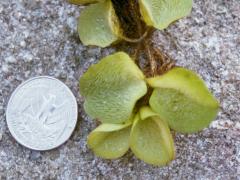 |
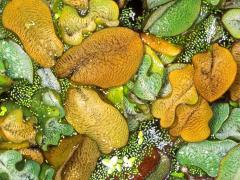
giant salvinia
|
| Scott Robinson, Georgia Department of Natural Resources, bugwood.org | Scott Bauer, USDA Agricultural Research Service, bugwood.org |
Foliage
The surfaces of the leaves have rows of arching hairs that look like little eggbeaters.
|
|
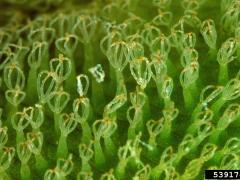 |
| Troy Evans, Great Smoky Mountains National Park, bugwood.org | Barry Rice, sarracenia.com, bugwood.org |
Plants
Plants reproduce by spores and by budding of broken stems or attached nodes.
 |
 |
| Victor Ramey, University of Florida, bugwood.org | Barry Rice, sarracenia.com, bugwood.org |
Native species That Resemble Giant Salvinia
Azolla caroliniana, Carolina mosquitofern – Images at invasive.org
 |
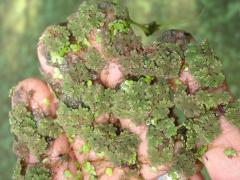 |
|
Graves Lovell, Alabama Department of Conservation and Natural Resources, bugwood.org |
Graves Lovell, Alabama Department of Conservation and Natural Resources, bugwood.org |
Marsilea villosa, villous waterclover – Images at invasive.org
 |
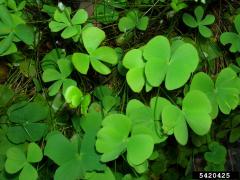 |
| Forest & Kim Starr, Starr Environmental, bugwood.org | Forest & Kim Starr, Starr Environmental, bugwood.org |
Additional Images for Giant Salvinia
Learning Resources for Giant Salvinia
Recognition Card – University of Florida, Institute of Food and Agricultural Sciences (IFAS) Extension
Field Notes: Biocontrol of Giant Salvinia: Video – Texas Parks and Wildlife
Fighting Invasives: Video – Texas Parks and Wildlife
Additional Information, Biology, Control and Management Resources
Control and management recommendations vary according to individual circumstances. Location, habitat, weather, and a variety of other conditions are factors that help determine the best treatment choice. To find the safest and most effective treatment for your situation, consult your state’s land-grant institution. If you will use chemicals as part of the control process, always refer to the product label.
United States Land Grant University System – Find your Land Grant University’s College of Agriculture, University Cooperative Extension Service, or other related partner on this map provided by USDA.
Pest Alert – USDA APHIS PPQ
Plant Invaders of Mid-Atlantic Natural Areas – National Park Service and U.S. Fish and Wildlife Service
Biological Control of Invasive Plants in the Eastern United States – USDA Forest Service
Domestic Programs Pest Evaluation – USDA Animal and Plant Health Inspection Services (APHIS) Plant Protection and Quarantine (PPQ)
Invasive Plant Atlas of New England – University of Connecticut
Federal Noxious Weed Disseminules of the United States – USDA APHIS
Global Invasive Species Database – Invasive Species Specialist Group
Center for Invasive and Aquatic Plants – University of Florida IFAS Extension
Invasives Database – TexasInvasives.org

